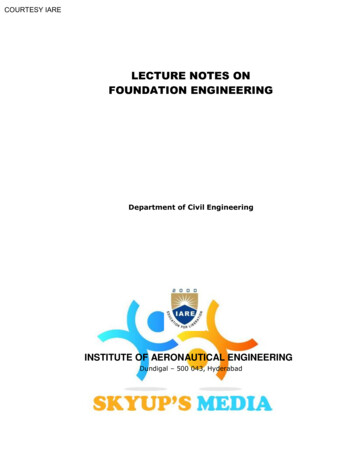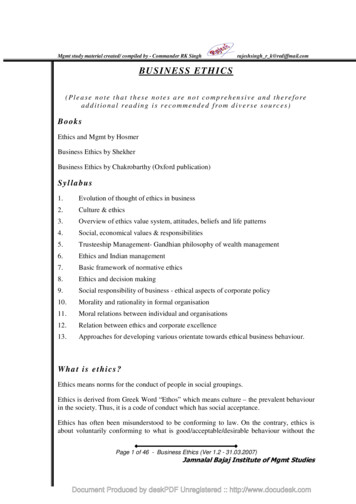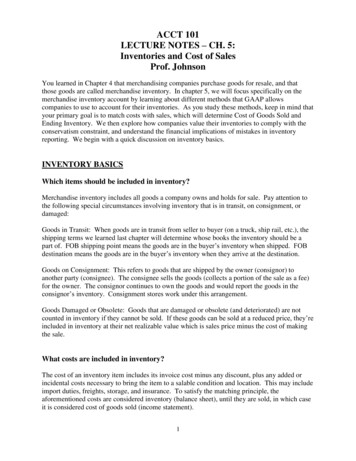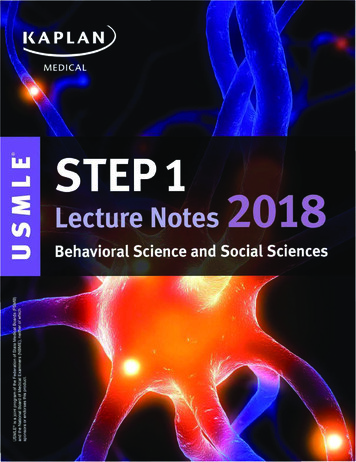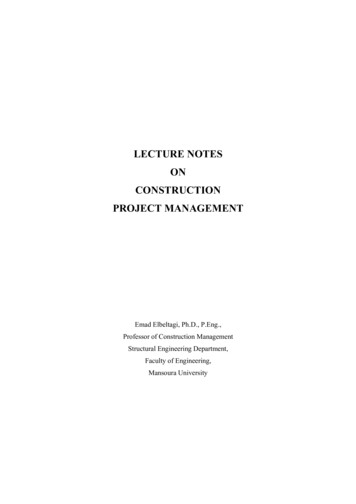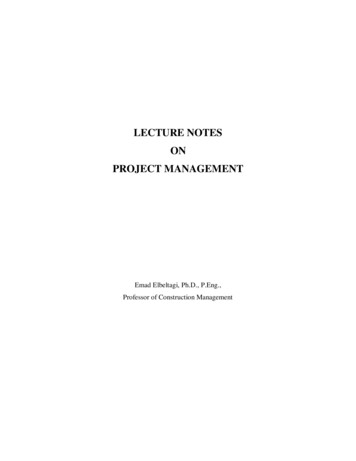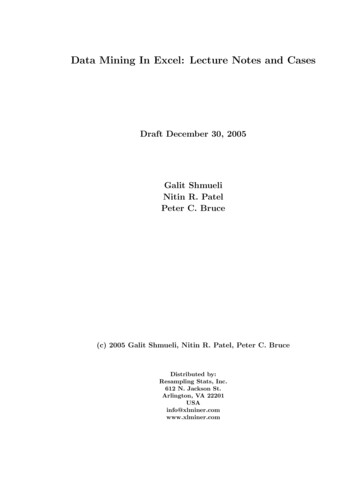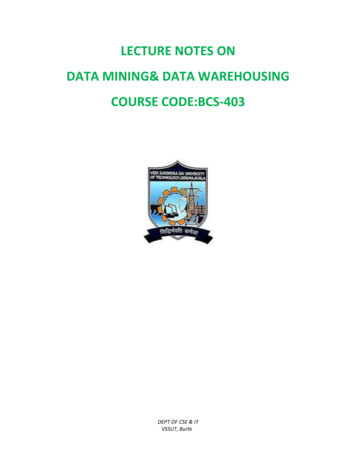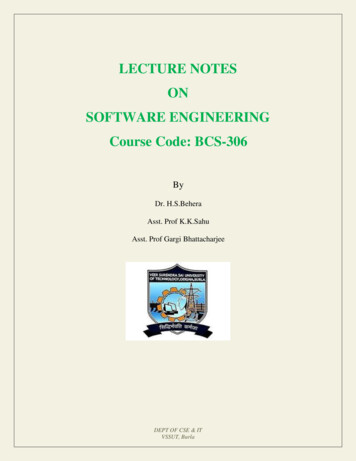
Transcription
LECTURE NOTESONSOFTWARE ENGINEERINGCourse Code: BCS-306ByDr. H.S.BeheraAsst. Prof K.K.SahuAsst. Prof Gargi BhattacharjeeDEPT OF CSE & ITVSSUT, Burla
DISCLAIMERTHIS DOCUMENT DOES NOT CLAIM ANY ORIGINALITY ANDCANNOT BE USED AS A SUBSTITUTE FOR PRESCRIBEDTEXTBOOKS. THE INFORMATION PRESENTED HERE ISMERELY A COLLECTION BY THE COMMITTEE MEMBERS FORTHEIR RESPECTIVE TEACHING ASSIGNMENTS. VARIOUSTEXT BOOKS AS WELL AS FREELY AVAILABLE MATERIALFROM INTERNET WERE CONSULTED FOR PREPARING THISDOCUMENT. THE OWNERSHIP OF THE INFORMATION LIESWITH THE RESPECTIVE AUTHORS OR INSTITUTIONS.DEPT OF CSE & ITVSSUT, Burla
SYLLABUSModule I:Introductory concepts: Introduction, definition, objectives, Life cycle – Requirements analysisand specification. Design and Analysis: Cohesion and coupling, Data flow oriented Design:Transform centered design, Transaction centered design. Analysis of specific systems likeInventory control, Reservation system.Module II:Object-oriented Design: Object modeling using UML, use case diagram, class diagram,interaction diagrams: activity diagram, unified development process.Module III:Implementing and Testing: Programming language characteristics, fundamentals, languages,classes, coding style efficiency. Testing: Objectives, black box and white box testing, varioustesting strategies, Art of debugging. Maintenance, Reliability and Availability: Maintenance:Characteristics, controlling factors, maintenance tasks, side effects, preventive maintenance – ReEngineering – Reverse Engineering – configuration management – Maintenance tools andtechniques. Reliability: Concepts, Errors, Faults, Repair and availability, reliability andavailability models. Recent trends and developments.Module IV:Software quality: SEI CMM and ISO-9001. Software reliability and fault-tolerance, softwareproject planning, monitoring, and control. Computer-aided software engineering (CASE),Component model of software development, Software reuse.Text Book:1. Mall Rajib, Fundamentals of Software Engineering, PHI.2. Pressman, Software Engineering Practitioner’s Approach, TMH.DEPT OF CSE & ITVSSUT, Burla
CONTENTSModule 1:Lecture 1: Introduction to Software EngineeringLecture 2: Software Development Life Cycle- Classical Waterfall ModelLecture 3: Iterative Waterfall Model, Prototyping Model, Evolutionary ModelLecture 4: Spiral ModelLecture 5: Requirements Analysis and SpecificationLecture 6: Problems without a SRS document, Decision Tree, Decision TableLecture 7: Formal System SpecificationLecture 8: Software DesignLecture 9: Software Design StrategiesLecture 10: Software Analysis & Design ToolsLecture 11: Structured DesignModule 2:Lecture 12: Object Modelling Using UMLLecture 13: Use Case DiagramLecture 14: Class DiagramsLecture 15: Interaction DiagramsLecture 16: Activity and State Chart DiagramDEPT OF CSE & ITVSSUT, Burla
Module 3:Lecture 17: CodingLecture 18: TestingLecture 19: Black-Box TestingLecture 20: White-Box TestingLecture 21: White-Box Testing (cont.)Lecture 22: Debugging, Integration and System TestingLecture 23: Integration TestingLecture 24: Software MaintenanceLecture 25: Software Maintenance Process ModelsLecture 26: Software Reliability and Quality ManagementLecture 27: Reliability Growth ModelsModule 4:Lecture 28: Software QualityLecture 29: SEI Capability Maturity ModelLecture 30: Software Project PlanningLecture 31: Metrics for Software Project Size EstimationLecture 32: Heuristic Techniques, Analytical Estimation TechniquesLecture 33: COCOMO ModelLecture 34: Intermediate COCOMO ModelLecture 35: Staffing Level EstimationDEPT OF CSE & ITVSSUT, Burla
Lecture 36: Project SchedulingLecture 37: Organization StructureLecture 38: Risk ManagementLecture 39: Computer Aided Software EngineeringLecture 40: Software ReuseLecture 41: Reuse ApproachReferencesDEPT OF CSE & ITVSSUT, Burla
MODULE 1LECTURE NOTE 1INTRODUCTION TO SOFTWARE ENGINEERINGThe term software engineering is composed of two words, software and engineering.Software is more than just a program code. A program is an executable code, which servessome computational purpose. Software is considered to be a collection of executableprogramming code, associated libraries and documentations. Software, when made for aspecific requirement is called software product.Engineering on the other hand, is all about developing products, using well-defined, scientificprinciples and methods.So, we can define software engineering as an engineering branch associated with thedevelopment of software product using well-defined scientific principles, methods andprocedures. The outcome of software engineering is an efficient and reliable software product.IEEE defines software engineering as:The application of a systematic, disciplined, quantifiable approach to the development,operation and maintenance of software.We can alternatively view it as a systematic collection of past experience. The experience isarranged in the form of methodologies and guidelines. A small program can be written withoutusing software engineering principles. But if one wants to develop a large software product, thensoftware engineering principles are absolutely necessary to achieve a good quality software costeffectively.Without using software engineering principles it would be difficult to develop large programs. Inindustry it is usually needed to develop large programs to accommodate multiple functions. Aproblem with developing such large commercial programs is that the complexity and difficultylevels of the programs increase exponentially with their sizes. Software engineering helps toreduce this programming complexity. Software engineering principles use two importanttechniques to reduce problem complexity: abstraction and decomposition. The principle ofabstraction implies that a problem can be simplified by omitting irrelevant details. In otherwords, the main purpose of abstraction is to consider only those aspects of the problem that arerelevant for certain purpose and suppress other aspects that are not relevant for the givenpurpose. Once the simpler problem is solved, then the omitted details can be taken intoconsideration to solve the next lower level abstraction, and so on. Abstraction is a powerful wayof reducing the complexity of the problem. The other approach to tackle problem complexity isDEPT OF CSE & ITVSSUT, Burla
decomposition. In this technique, a complex problem is divided into several smaller problemsand then the smaller problems are solved one by one. However, in this technique any randomdecomposition of a problem into smaller parts will not help. The problem has to be decomposedsuch that each component of the decomposed problem can be solved independently and then thesolution of the different components can be combined to get the full solution. A gooddecomposition of a problem should minimize interactions among various components. If thedifferent subcomponents are interrelated, then the different components cannot be solvedseparately and the desired reduction in complexity will not be realized.NEED OF SOFTWARE ENGINEERINGThe need of software engineering arises because of higher rate of change in user requirementsand environment on which the software is working. Large software - It is easier to build a wall than to a house or building, likewise, as thesize of software become large engineering has to step to give it a scientific process. Scalability- If the software process were not based on scientific and engineeringconcepts, it would be easier to re-create new software than to scale an existing one. Cost- As hardware industry has shown its skills and huge manufacturing has lower downthe price of computer and electronic hardware. But the cost of software remains high ifproper process is not adapted. Dynamic Nature- The always growing and adapting nature of software hugely dependsupon the environment in which the user works. If the nature of software is alwayschanging, new enhancements need to be done in the existing one. This is where softwareengineering plays a good role. Quality Management- Better process of software development provides better andquality software product.CHARACTERESTICS OF GOOD SOFTWAREA software product can be judged by what it offers and how well it can be used. This softwaremust satisfy on the following grounds: Operational Transitional MaintenanceDEPT OF CSE & ITVSSUT, Burla
Well-engineered and crafted software is expected to have the following characteristics:OperationalThis tells us how well software works in operations. It can be measured on: Budget Usability Efficiency Correctness Functionality Dependability Security SafetyTransitionalThis aspect is important when the software is moved from one platform to another: Portability Interoperability Reusability AdaptabilityMaintenanceThis aspect briefs about how well a software has the capabilities to maintain itself in the everchanging environment: Modularity Maintainability Flexibility ScalabilityIn short, Software engineering is a branch of computer science, which uses well-definedengineering concepts required to produce efficient, durable, scalable, in-budget and on-timesoftware productsDEPT OF CSE & ITVSSUT, Burla
LECTURE NOTE 2SOFTWARE DEVELOPMENT LIFE CYCLELIFE CYCLE MODELA software life cycle model (also called process model) is a descriptive and diagrammaticrepresentation of the software life cycle. A life cycle model represents all the activities requiredto make a software product transit through its life cycle phases. It also captures the order inwhich these activities are to be undertaken. In other words, a life cycle model maps the differentactivities performed on a software product from its inception to retirement. Different life cyclemodels may map the basic development activities to phases in different ways. Thus, no matterwhich life cycle model is followed, the basic activities are included in all life cycle modelsthough the activities may be carried out in different orders in different life cycle models. Duringany life cycle phase, more than one activity may also be carried out.THE NEED FOR A SOFTWARE LIFE CYCLE MODELThe development team must identify a suitable life cycle model for the particular project andthen adhere to it. Without using of a particular life cycle model the development of a softwareproduct would not be in a systematic and disciplined manner. When a software product is beingdeveloped by a team there must be a clear understanding among team members about when andwhat to do. Otherwise it would lead to chaos and project failure. This problem can be illustratedby using an example. Suppose a software development problem is divided into several parts andthe parts are assigned to the team members. From then on, suppose the team members areallowed the freedom to develop the parts assigned to them in whatever way they like. It ispossible that one member might start writing the code for his part, another might decide toprepare the test documents first, and some other engineer might begin with the design phase ofthe parts assigned to him. This would be one of the perfect recipes for project failure. A softwarelife cycle model defines entry and exit criteria for every phase. A phase can start only if itsphase-entry criteria have been satisfied. So without software life cycle model the entry and exitcriteria for a phase cannot be recognized. Without software life cycle models it becomes difficultfor software project managers to monitor the progress of the project.Different software life cycle modelsMany life cycle models have been proposed so far. Each of them has some advantages as well assome disadvantages. A few important and commonly used life cycle models are as follows: Classical Waterfall ModelDEPT OF CSE & ITVSSUT, Burla
Iterative Waterfall ModelPrototyping ModelEvolutionary ModelSpiral Model1. CLASSICAL WATERFALL MODELThe classical waterfall model is intuitively the most obvious way to develop software. Thoughthe classical waterfall model is elegant and intuitively obvious, it is not a practical model in thesense that it cannot be used in actual software development projects. Thus, this model can beconsidered to be a theoretical way of developing software. But all other life cycle models areessentially derived from the classical waterfall model. So, in order to be able to appreciate otherlife cycle models it is necessary to learn the classical waterfall model. Classical waterfall modeldivides the life cycle into the following phases as shown in fig.2.1:Fig 2.1: Classical Waterfall ModelFeasibility study - The main aim of feasibility study is to determine whether it would befinancially and technically feasible to develop the product.DEPT OF CSE & ITVSSUT, Burla
At first project managers or team leaders try to have a rough understanding of what isrequired to be done by visiting the client side. They study different input data to thesystem and output data to be produced by the system. They study what kind of processingis needed to be done on these data and they look at the various constraints on thebehavior of the system. After they have an overall understanding of the problem they investigate the differentsolutions that are possible. Then they examine each of the solutions in terms of what kindof resources required, what would be the cost of development and what would be thedevelopment time for each solution. Based on this analysis they pick the best solution and determine whether the solution isfeasible financially and technically. They check whether the customer budget would meetthe cost of the product and whether they have sufficient technical expertise in the area ofdevelopment.Requirements analysis and specification: - The aim of the requirements analysis andspecification phase is to understand the exact requirements of the customer and to documentthem properly. This phase consists of two distinct activities, namely Requirements gathering and analysisRequirements specificationThe goal of the requirements gathering activity is to collect all relevant information from thecustomer regarding the product to be developed. This is done to clearly understand the customerrequirements so that incompleteness and inconsistencies are removed.The requirements analysis activity is begun by collecting all relevant data regarding the productto be developed from the users of the product and from the customer through interviews anddiscussions. For example, to perform the requirements analysis of a business accounting softwarerequired by an organization, the analyst might interview all the accountants of the organization toascertain their requirements. The data collected from such a group of users usually containseveral contradictions and ambiguities, since each user typically has only a partial andincomplete view of the system. Therefore it is necessary to identify all ambiguities andcontradictions in the requirements and resolve them through further discussions with thecustomer. After all ambiguities, inconsistencies, and incompleteness have been resolved and allthe requirements properly understood, the requirements specification activity can start. Duringthis activity, the user requirements are systematically organized into a Software RequirementsSpecification (SRS) document. The customer requirements identified during the requirementsgathering and analysis activity are organized into a SRS document. The important components ofthis document are functional requirements, the nonfunctional requirements, and the goals ofimplementation.DEPT OF CSE & ITVSSUT, Burla
Design: - The goal of the design phase is to transform the requirements specified in the SRSdocument into a structure that is suitable for implementation in some programming language. Intechnical terms, during the design phase the software architecture is derived from the SRSdocument. Two distinctly different approaches are available: the traditional design approach andthe object-oriented design approach. Traditional design approach -Traditional design consists of two different activities; firsta structured analysis of the requirements specification is carried out where the detailedstructure of the problem is examined. This is followed by a structured design activity.During structured design, the results of structured analysis are transformed into thesoftware design.Object-oriented design approach -In this technique, various objects that occur in theproblem domain and the solution domain are first identified, and the differentrelationships that exist among these objects are identified. The object structure is furtherrefined to obtain the detailed design.Coding and unit testing:-The purpose of the coding phase (sometimes called theimplementation phase) of software development is to translate the software design into sourcecode. Each component of the design is implemented as a program module. The end-product ofthis phase is a set of program modules that have been individually tested. During this phase, eachmodule is unit tested to determine the correct working of all the individual modules. It involvestesting each module in isolation as this is the most efficient way to debug the errors identified atthis stage.Integration and system testing: -Integration of different modules is undertaken once they havebeen coded and unit tested. During the integration and system testing phase, the modules areintegrated in a planned manner. The different modules making up a software product are almostnever integrated in one shot. Integration is normally carried out incrementally over a number ofsteps. During each integration step, the partially integrated system is tested and a set ofpreviously planned modules are added to it. Finally, when all the modules have been successfullyintegrated and tested, system testing is carried out. The goal of system testing is to ensure thatthe developed system conforms to its requirements laid out in the SRS document. System testingusually consists of three different kinds of testing activities: α – testing: It is the system testing performed by the development team.β –testing: It is the system testing performed by a friendly set of customers.Acceptance testing: It is the system testing performed by the customer himself after theproduct delivery to determine whether to accept or reject the delivered product.System testing is normally carried out in a planned manner according to the system test plandocument. The system test plan identifies all testing-related activities that must be performed,DEPT OF CSE & ITVSSUT, Burla
specifies the schedule of testing, and allocates resources. It also lists all the test cases and theexpected outputs for each test case.Maintenance: -Maintenance of a typical software product requires much more than the effortnecessary to develop the product itself. Many studies carried out in the past confirm this andindicate that the relative effort of development of a typical software product to its maintenanceeffort is roughly in the 40:60 ratios. Maintenance involves performing any one or more of thefollowing three kinds of activities: Correcting errors that were not discovered during the product development phase. This iscalled corrective maintenance. Improving the implementation of the system, and enhancing the functionalities of thesystem according to the customer’s requirements. This is called perfective maintenance. Porting the software to work in a new environment. For example, porting may berequired to get the software to work on a new computer platform or with a new operatingsystem. This is called adaptive maintenance.Shortcomings of the classical waterfall modelThe classical waterfall model is an idealistic one since it assumes that no development error isever committed by the engineers during any of the life cycle phases. However, in practicaldevelopment environments, the engineers do commit a large number of errors in almost everyphase o
The term software engineering is composed of two words, software and engineering. Software is more than just a program code. A program is an executable code, which serves some computational purpose. Software is considered to be a collection of executable progr

